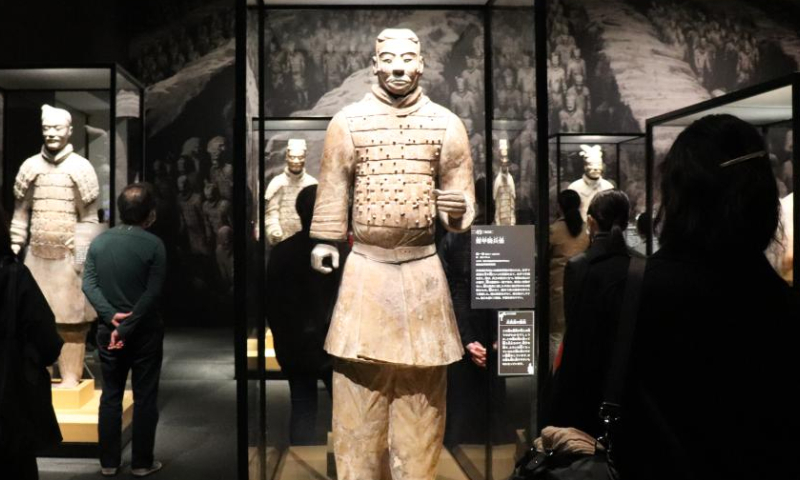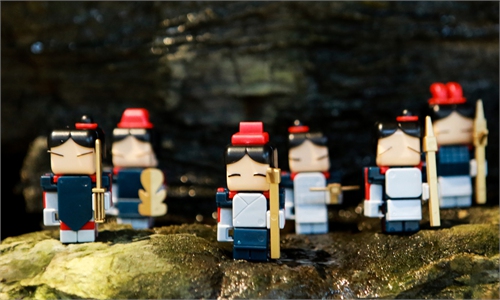
Visitors are seen at the media preview of the exhibition "Terracotta Warriors and Ancient China: Heritage from the Qin and Han Dynasty" at the Ueno Royal Museum in Tokyo, Japan, on Nov. 21, 2022. In commemoration of the 50th anniversary of the normalization of China-Japan diplomatic relations, the exhibition recently opened at the Ueno Royal Museum in Tokyo, the last leg of its nearly year-long traveling exhibition in Japan.
In commemoration of the 50th anniversary of the normalization of China-Japan diplomatic relations, the exhibition Terracotta Warriors and Ancient China: Heritage from the Qin and Han Dynasty recently opened at the Ueno Royal Museum in Tokyo, the last leg of its nearly year-long tour in Japan.
"I think the Terracotta Warriors should also be called ambassadors, because they, like giant pandas, can make people feel the charm of China wherever they go," Japanese historian and honorary professor of Gakushuin University Kazuyuki Tsuruma said.
Tsuruma is a history professor specializing in the study of ancient Chinese history. He told the Xinhua News Agency that another important reason why Japanese young people like to see Terracotta Warriors and Horses and learn about the history of the Qin (221BC-206BC) and Han (206BC-AD25) dynasties is that young Japanese people have a certain ability to read Chinese.
In 1974, after the Terracotta Army was discovered, it caused a sensation all over the world. In 1976, the first overseas exhibition of Terracotta Warriors was held in Japan.
Tang Qishan, curator of the current exhibition and executive director of the Japan-China Cultural Association, said, "At that time, about 1.5 million people queued up to visit the Tokyo National Museum. The popularity was no less than that of giant pandas coming to Japan."
Tang said that he hopes the Japanese people can learn about the splendid culture of China's Qin and Han dynasties through the exhibition, and also review the history of China-Japan cultural exchanges in 1976.
Previous exhibitions in Kyoto, Shizuoka and Nagoya have been very successful with already 240,000 visitors, Tang said, adding that "what makes us even more delighted is that there are so many young people among the visitors. We are very content with the enthusiasm shown by young Japanese people for Chinese Qin culture."
With a total of 121 sets of cultural relics from cultural institutions and museums in China's Shaanxi and Hunan provinces, the large-scale exhibition displays the Terracotta Warriors and Horses, stone artifacts, bronze wares and other exhibits that span from the Western Zhou Dynasty (1046BC-771BC) to the Eastern Han Dynasty (25-220).
Guo Xiangdong, deputy director of the Emperor Qinshihuang's Mausoleum Site Museum, said, "You can get a close 360-degree view of the details of the exhibited Terracotta Warriors and Horses, and tell the specialities and rank of the warriors by their armor and headgear."
In the exhibition hall, one of the exhibits, No. 2 Bronze Chariot and Horse, is surrounded by a circle of manga works.
"This is a very popular Japanese manga series titled Kingdom that is set during the Qin and Han dynasties. You can see the bronze chariots and horses illustrated in the manga," Guo explained.
"This way of displaying comics and real cultural relics at the same time in the same space is also an important reason why it attracts so many young people," Guo added.
Tsuruma said that during his more than 40 years of teaching at the university, many students have come to him to learn about ancient Chinese history. He would help young Japanese improve their Chinese reading ability through historical documents such as The Records of the Grand Historian, and combine historical documents with archaeological objects to enhance students' interest in learning.
This exhibition is an excellent opportunity for more young Japanese to learn about ancient Chinese history and culture through living cultural relics, Tsuruma said.
"Cultural relics exhibitions are the best means of people-to-people cultural exchanges, and I hope the Terracotta ambassadors can play a better role in promoting exchanges and friendship between the two peoples," Tsuruma noted.

